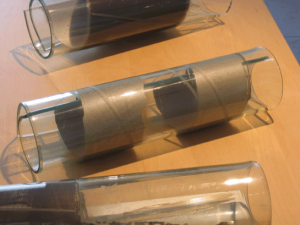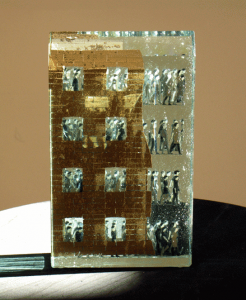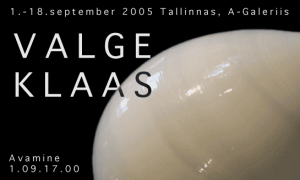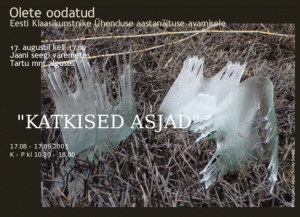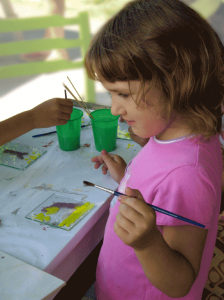DAYS OF WHITE GLASS IN HAAPSALU
3rd International Hot Glass Symposium
Evald Okas Museum, August 16-23, 2005
Last week,the glass artists of Estonia had the pleasure of welcoming colleagues from around the world. The third hot glass workshop, initiated by Kai Koppel, lasted for a week and culminated with a glass show on the museum’s second floor. The exhibit, which stays open till Aug.14, presents a selection of pieces that were created during the workshop before a live audience, and some previously executed works.
This year, the common denominator was the milky white glass melting in the furnace. Many of the participants related this to the Legend of Haapsalu. The primeval archetype of Woman and Moon, present in the White Lady’s story, brought up a wide range of interpretations – some more abstract than others. I was myself surprised of the broad range of meanings hidden in that old folk tale – material for both Symbolists, Feminists, and anyone in between.
The Two Extremes of Glass
Professional slang states the division of glass art into “cold” and “hot”. Of these, the first is often born in the silence of some cellar, through months of grinding and hard work; whilst the latter appears more playful, artistic, and process-oriented. Borrowing from another slang – a prime-time sport. Greater performances of this art form take place in the open, light summertime air. The Haapsalu workshop was no exception – centering around a furnace that squat in the museum yard.
Playful does not necessarily mean easy, nor accessible. Aside from artistic talent, glassblowing requires a good deal of physical skill. People, who possess both of these, are rare everywhere. And so, our workshop – as many others – brings together an international crew.
White Glass and its Many Forms
This year, visitors to Haapsalu came from three continents. Some, loving the town’s atmosphere, came back for the second or third time. Sung-Hwan Hong (Korea), an elegant juggler with glass, created short-lived pieces – quite untypical of a glass artist. Robert Tannahill (Canada) portrayed the Lady, having sacrificed his own hair for the cause. Nicolas Morin and Catherine Sintés (France) adapted the methods of fibre arts in their oeuvre “Tricot Suspendu”. Lachezar Dochev (Bulgaria) installed a lacy boudoir for the Lady. Anda Munkevica (Latvia) combined a ready-made chain with glass links in “Rip This Joint”. Vesa Varrela (Finland) and Remigius Kriukas (Lithuania) adapted nature’s forms in their sculptures.
Newcomers brought with them a host of sensations. Cicy Ching (Hong Kong) showed slides of her amazingly nuanced jewellery. Her installation “In Tears”, created on site, reflected the legend’s tragic – of being buried alive. Sue Parry (England), bursting with the radicality of Punk, was comparably milder in her art – nature-inspired, verging on the purely abstract. The day’s events took form in her piece “Night Swim”. The bohéme primadonna Renate Korinek (Austria) utilized the fluidity of the material to express sensuality and erotic. Barbala Gulbe (Latvia) – “Always So” reflected on the cycles of the Moon, and their power over humans. Gunilla Lifvergren (Sweden), surfing the Neopop wave, brought supersized glass receipts titled “The Last Bill”.
My favourite Estonian work was Toomas Riisalu’s “Hedgehogs Go to Heaven” – a piece possessing integrity of form and content.
Many works took inspiration from the spherical form, the keywords being egg, expectation, beginning, morning etc. (Kai Saarepuu, Virve Kiil, Kairi Orgusaar and Eeva Käsper). An ironic/conceptual approach was taken by Kati Kerstna, Erki Kannus and Merle Kannus. There were glass beads by Liisi Junolainen and Maret Sarapu; fragile miniatures by Kairi Orgusaar; functional forms by Kai Koppel, Virve Kiil, Kaja and Eero Vaikre; romantic storytelling by Sofi Arshas (The Coming of the Sylphid”) and Viivi-Ann Keerdo (“The Age of Ladies”).
Satellites
Besides the main course – the symposium itself – numerous snacks and tidbits were served to the townfolks and visitors. August 14 was a day for children, who had the opportunity of practising enamel painting, assisted by professionals. Maestro Evald Okas lent his advice and example, making an improvised painting of a curvacious dame.
Rait Prääts opened his show “Glass Houses” at the Viie Risti Gallery. Bulgarians Lachezar Dochev and Ventseslav Danev exhibited at the cultural center, showing, respectively, monumental glass sculptures and photogram collages. In the Kuke Gallery, Remigius Kriukas (Lithuania) had laid out his glass paperweights. Erki and Merle Kannus made a temporary sound installation “An Ode for Travellers” at the old railway station.
Society reports
The milling around the glass furnace did not show signs of slowing down until way past midnight. After all, one cannot let a good working mood go to waste. Having twisted some glass, one could continue twisting one’s body to the rhythms – Oroboro, a Latvian New Age band, had come to play at the workshop. After those guys had left us, we continued hitting drums and various other utensils. Exotic cuisine ranging from Wok to Kama was served daily by the representatives of different nationalities. Some enjoyed a good beach weather, some took healing mud baths, went to concerts and sightseeing. We exchanged information, contacts, and memorabilia. The guests left with a note of sadness, many wishing to return; their luggage included Haapsalu shawls, packets of Kama, and perhaps a few happy memories.
Merle Kannus
To be published in the arts&culture weekly Sirp

